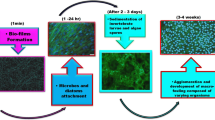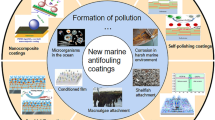Abstract
A series of novel zinc-polyurethane copolymers, which contained zinc cations in the form of polymeric salt and can be exchanged with the sodium ions in sea water, was prepared. As the ion exchange reaction proceeded, the zinc-polyurethane copolymers became soluble and leached out by the flow of sea water. The self-polishing rates of marine antifouling coatings formulated with the polymers proved to be easily controlled by the amount of 2,2-bis(hydroxymethyl) propionic acid. Marine field test revealed that zinc-polyurethane antifouling coatings had excellent efficiency in preventing marine biofouling for more than 12 months. These results proved that the zinc-polyurethane copolymers were a good candidate for the preparation of long-efficiency and controllable marine antifouling coatings.












Similar content being viewed by others
References
Selim, MS, Shenashen, MA, El-Safty, SA, et al. “Recent Progress in Marine Foul-Release Polymeric Nanocomposite Coatings.” Prog. Mater. Sci., 87 1–32 (2017)
Liu, Y, Shao, X, Huang, J, et al. “Flame Sprayed Environmentally Friendly High Density Polyethylene (HDPE)-Capsaicin Composite Coatings for Marine Antifouling Applications.” Mater. Lett., 238 46–50 (2019)
Seo, DH, Pineda, S, Woo, YC, et al. “Anti-fouling Graphene-Based Membranes for Effective Water Desalination.” Nat. Commun., 9 683 (2018)
Jakobi, V, Schwarze, J, Finlay, JA, et al. “Amphiphilic Alginates for Marine Antifouling Applications.” Biomacromolecules, 19 402–408 (2018)
Yang, W, Lin, P, Cheng, D, et al. “Contribution of Charges in Polyvinyl Alconol Networks to Marine Antifouling.” ACS Appl. Mater. Interfaces, 9 18295–18304 (2017)
Sae-ung, P, Kolewe, KW, Bai, Y, et al. “Antifouling Stripes Prepared from Clickable Zwitterionic Copolymers.” Langmuir, 33 7028–7035 (2017)
Xie, Q, Pan, J, Ma, C, et al. “Dynamic Surface Antifouling: Mechanism and Systems.” Soft. Matter, 15 1087 (2019)
Kim, S-H, Kim, S-J, Lee, J-S, et al. “Acute Effects of Heavy Metals on the Expression of Glutathione-Related Antioxidant Genes in the Marine Ciliate Euplotes crassus.” Mar. Pollut. Bull., 85 455–462 (2014)
Liu, H, He, J, Zhao, R, et al. “A Novel Biomarker for Marine Environmental Pollution of Pi-class Glutathione S-transferase from Mytilus coruscus.” Ecotox. Environ. Safe., 118 47–54 (2015)
Bonnefille, B, Gomez, E, Courant, F, et al. “Diclofenac in the Marine Environment: A Review of Its Occurrence and Effects.” Mar. Pollut. Bull., 31 496–506 (2018)
Yi, J, Huang, C, Zhuang, H, et al. “Degradable Polyurethane Based on Star-Shaped Polyester Polyols (Trimethylolpropane and ε-Caprolactone) for Marine Antifouling.” Prog. Org. Coat., 87 161–170 (2015)
Chen, S, Ma, C, Zhang, G, “Biodegradable Polymer as Controlled Release System of Organic Antifoulant to Prevent Marine Biofouling.” Prog. Org. Coat., 104 58–63 (2017)
Chen, S, Ma, C, Zhang, G, “Biodegradable Polymers for Marine Antibiofouling: Poly(ε-caprolactone)/Poly(butylene succinate) Blend as Controlled Release System of Organic Antifoulant.” Polymer, 90 215–221 (2016)
Yonehara, Y, Yamashita, H, Kawamura, C, Itoh, K, “A New Antifouling Paint Based on a Zinc Acrylate Copolymer.” Prog. Org. Coat., 42 150–158 (2001)
Yousefi, E, Dolati, A, Najafkhani, H, “Preparation of Robust Antistatic Waterborne Polyurethane Coating.” Prog. Org. Coat., 139 105450 (2020)
Suna, Y, Liu, C, Hong, Y, Liu, R, Zhou, X, “Synthesis and Application of Self-crosslinking and Flame Retardant Waterborne Polyurethane as Fabric Coating Agent.” Prog. Org. Coat., 137 105323 (2019)
Acknowledgments
This research was supported by Zhejiang Provincial Natural Science Foundation of China under Grant No. LQ19E030012. This research was supported by Educational Commission of Zhejiang Province of China Grant No. Y201840368. This research was supported by the Zhejiang key laboratory of yarn material forming and composite processing technology (MTC2020-22).
Author information
Authors and Affiliations
Corresponding author
Additional information
Publisher's Note
Springer Nature remains neutral with regard to jurisdictional claims in published maps and institutional affiliations.
Rights and permissions
About this article
Cite this article
Dai, Z., Cao, M., Li, S. et al. A novel marine antifouling coating based on a self-polishing zinc-polyurethane copolymer. J Coat Technol Res 18, 1333–1343 (2021). https://doi.org/10.1007/s11998-021-00496-8
Received:
Revised:
Accepted:
Published:
Issue Date:
DOI: https://doi.org/10.1007/s11998-021-00496-8




